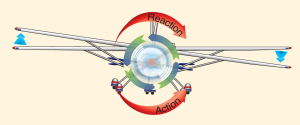It’s been a few days since I last posted; I believe we left off discussing Bernoulli’s principal as it relates to lift. Today, I want to discuss another important mathematician/physicist from around the same time, Sir Isaac Newton.
Sir Newton came up with what is known today as Newton’s Three Laws of Motion. The law in which we will focus on today is the third law: for every action there is an equal and opposite reaction. Along with Bernoulli, Newton’s Third Law is also a direct contributor to lift. Bob Gardner describes this in The Complete Private Pilot:
A second contributor to total lift is Newton’s Third Law: for every action there is an equal and opposite reaction. As the airfoil moves through the air it pushes the air downward and, in accordance with Newton’s Law, the air exerts an equal upward force. Because of differences in wing design and operating conditions, it is impossible to say what percentage of total lift can be attributed to Bernoulli or to Newton at any time.
Imagine as the wing passes through space the air strikes the underside of the wing and is deflected downward. Based on Newton’s Third Law the opposite reaction would be a force created in an upwards direction, better known to a pilot as lift. Remember when you were a kid and stuck your hand out the window like a wing? I’m sure you could feel the wind wanting to push your hand back and up, this is the same exact concept. Pretty cool stuff!
Can you think of any other areas where Newton’s Third Law might come into play? I’ll give you a clue, think about the four forces on the aircraft that we have already discussed.
How about thrust? An aircraft propeller’s job is to create thrust—it does this by pushing air backyards, the resultant force is the air pushing the propeller in the opposite direction (forwards). The same can be said for a jet engine.
Here’s another example, imagine yourself sitting in the cockpit of a Cessna 172 with the engine running. Looking out the window you will notice that the propeller is turning to your right. Obviously we all know that the prop is connected to the engine which in turn is bolted to the airframe (I hope you knew that). The opposing force from the propeller is felt on the airframe around the longitudinal axis, so the airframe wants to roll left as the prop turns right (see the figure below). This is known as torque reaction and manufactures take this into effect when designing aircraft. This is an area you will get more into when discussing P-Factor and torque.
Here are two questions that you are likely to see on your FAA Knowledge test that cover the information we have discussed. I will post the answers in the comments section of this post on Monday. Now enough of this Aerodynamics talk, let’s get into weather next week!
1. In what flight condition is torque effect the greatest in a single-engine airplane?
A—Low airspeed, high power, high angle of attack.
B—Low airspeed, low power, low angle of attack.
C—High airspeed, high power, high angle of attack.
2. Which statement relates to Bernoulli’s principle?
A—For every action there is an equal and opposite reaction.
B—An additional upward force is generated as the lower surface of the wing deflects air downward.
C—Air traveling faster over the curved upper surface of an airfoil causes lower pressure on the top surface.
Know the answer? Have a further question for the CFI? Leave a comment below, or send an email to [email protected], and be sure to check the comments on this post next week for the answers!





